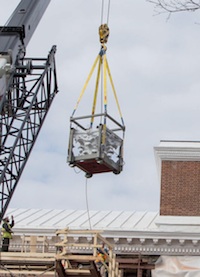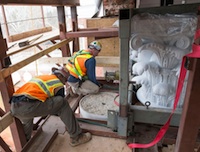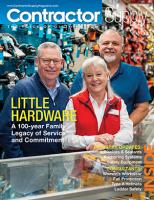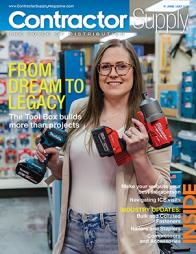Cool Stories: Thomas Jefferson's UW Virginia Rotunda building restoration
Historic structure's column capitals are recreated with aid of laser scanners.
 |
|
The University of Virginia has begun replacing the capitals on its historic Rotunda.Each capital weighs 6,300 pounds and is sculpted from Carrara marble, the same high-quality marble Jefferson originally specified. |
 |
|
One of the capitals is lifted toward workers who will install it atop one of the building's columns. |
 |
|
Rugo Stone workers maneuver the new capital into place over a column. |
The University of Virginia has begun replacing the capitals on its historic Rotunda. The university unveiled one of the new capitals - load-bearing structures at the top of each column - at a news conference last Monday. The current capitals, which are more than 100 years old, have been shrouded in black construction cloth since 2009 because they are crumbling.
Brian Hogg, the university’s preservation planner, said the marble on the old capitals has eroded after years of exposure to the elements. Hogg demonstrated the problem by taking a piece of stone in his hand and rubbing it until it disintegrated, like a lump of sugar.
“There’s no good way to fix the stone after reaching that point,” Hogg said.
The current capitals were brought in after a fire in 1895 damaged the originals , which were designed by UVa founder Thomas Jefferson. One of the original capitals, now displayed in the Fralin Museum of Art, is mostly intact, while the rest are preserved in smaller pieces.
The replacements, installed in 1897, were carved out of a different type of marble that was less dense than the original material, which came from Carrara, Italy. The city is renowned for exporting high-quality marble, the same material used in the Pantheon in Rome.
The new Rotunda capitals are closer to Jefferson’s design. They were all fabricated in Carrara out of the same marble as the originals; the university studied Jefferson’s design and tried to have it replicated.
“This is the material Mr. Jefferson chose and he chose well,” said UVa President Teresa A. Sullivan. “This is as exact a copy as we could make.”
The university used a combination of state and private money to contract Pedrini Sculptors in Italy to carve the 6,300-pound capitals. Craftsmen there used laser scanners to analyze pieces of the originals and create a computer model. The sculpting process was a combination of computer control and hand-carving.
Crews will continue installing the replacement capitals throughout the year. Work on the capitals on the south portico will stretch into March, while the capitals on the north portico will be replaced later this year, said UVa spokesman McGregor McCance.
Click here to read the entire article.
For more on the Rotunda restoration, see rotunda.virginia.edu.















